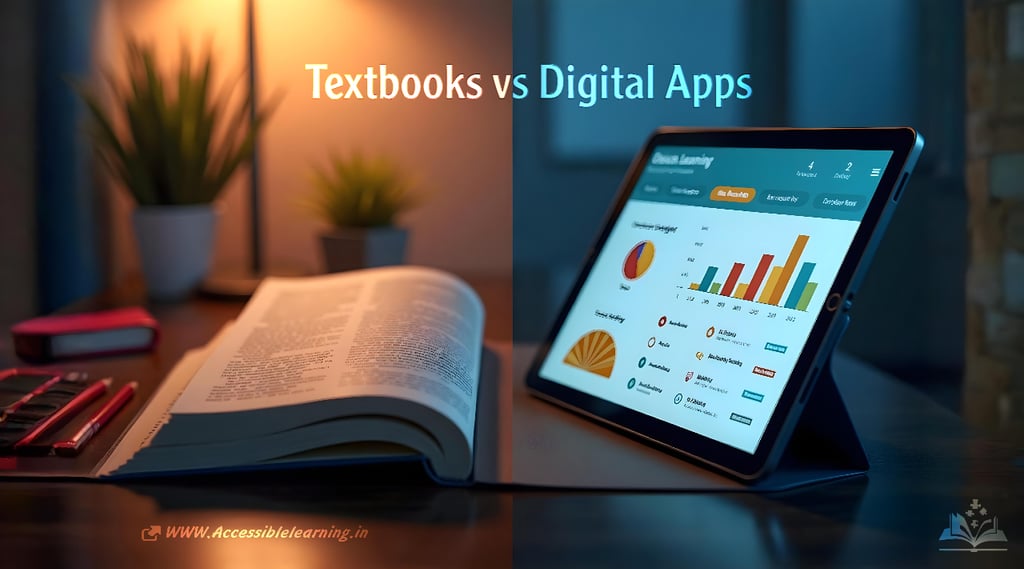
Textbooks vs Interactive Apps: Which Works Better for Modern Learners?
Discover whether textbooks or interactive apps deliver better learning outcomes for modern students. Evidence-based analysis of effectiveness, engagement, and costs.
A LEARNINGAI/FUTUREEDUCATION/KNOWLEDGE
Sachin K Chaurasiya
6/11/20256 min read


The landscape of education has undergone a dramatic transformation in recent years, with traditional textbooks facing unprecedented competition from interactive learning applications. As educators, students, and institutions grapple with choosing the most effective learning tools, a fundamental question emerges: which medium truly serves modern learners better?
This debate extends beyond simple preference, touching on cognitive science, accessibility, cost-effectiveness, and the evolving nature of how we process and retain information in the digital age.
The Case for Traditional Textbooks
Deep Reading & Comprehension Benefits
Research consistently demonstrates that physical textbooks promote deeper reading comprehension compared to digital alternatives. A landmark study by Liu and Huang found that students reading from paper demonstrated 10-15% better comprehension scores on complex analytical tasks. The tactile experience of turning pages creates spatial memory markers that help readers navigate and recall information more effectively.
Physical textbooks eliminate the digital distractions that plague screen-based learning. Without notifications, hyperlinks, or the temptation to multitask, students maintain sustained focus for longer periods. This concentrated attention proves crucial for absorbing complex theoretical concepts that require deep cognitive processing.
Reliability & Consistent Access
Textbooks offer unparalleled reliability in educational settings. They function without internet connectivity, battery power, or software updates. This consistency proves especially valuable in regions with limited technological infrastructure or during extended study sessions where device reliability becomes paramount.
The permanence of printed text also provides psychological comfort to many learners. Students can annotate margins, highlight passages, and create personal reference systems that remain intact throughout their academic journey. These physical interactions with content create stronger neural pathways associated with memory formation.
Cost-Effective Long-Term Investment
While initial textbook costs appear substantial, their durability often makes them more economical over time. A single textbook can serve multiple academic terms and often retains resale value. Libraries and educational institutions can share physical copies among students, maximizing resource utilization without recurring subscription fees or licensing restrictions.


The Interactive App Advantage
Personalized Learning Pathways
Modern learning applications excel at adapting to individual student needs through sophisticated algorithms and data analytics. Platforms like Khan Academy and Duolingo track user progress, identify knowledge gaps, and adjust difficulty levels in real time. This personalization ensures that students receive targeted instruction precisely when they need it most.
Interactive apps can present the same concept through multiple modalities—visual animations, audio explanations, interactive simulations, and gamified exercises. This multi-sensory approach accommodates diverse learning styles more effectively than static text-based presentations.
Immediate Feedback & Assessment
Digital learning platforms provide instantaneous feedback that transforms the learning process. Students receive immediate correction on mistakes, preventing the reinforcement of incorrect concepts. This rapid feedback loop accelerates learning compared to traditional methods where students might wait days or weeks for graded assignments.
Advanced applications incorporate spaced repetition algorithms that optimize review timing based on individual forgetting curves. This scientific approach to memory consolidation significantly improves long-term retention rates compared to traditional study methods.
Engagement Through Gamification
Interactive elements, progress tracking, achievements, and social features tap into intrinsic motivation systems that make learning more engaging. Research from the University of Colorado demonstrated that students using gamified learning platforms showed 12% higher engagement rates and 9% better knowledge retention compared to traditional instruction methods.
The social components of many apps—leaderboards, peer challenges, and collaborative features—create learning communities that extend beyond classroom boundaries. This social reinforcement provides additional motivation for continued engagement with educational content.
Comparative Analysis: Where Each Medium Excels
Content Depth & Complexity
Textbooks maintain significant advantages for subjects requiring extensive theoretical background, complex mathematical derivations, or detailed historical analysis. The linear structure of books naturally supports building comprehensive understanding through sequential concept development.
Interactive apps excel in subjects requiring practical application, skill development, or frequent practice. Language learning, coding, mathematics problem-solving, and scientific simulations benefit enormously from interactive formats that allow immediate application of concepts.
Learning Style Accommodation
Traditional textbooks primarily serve visual learners who process information effectively through reading and written exercises. However, they offer limited accommodation for kinesthetic, auditory, or visual-spatial learners.
Interactive applications naturally accommodate multiple learning preferences through varied presentation formats, interactive exercises, and multimedia integration. This flexibility makes them particularly effective for diverse classroom environments.
Assessment & Progress Tracking
Textbook-based learning relies heavily on periodic testing and subjective progress evaluation. While this approach works well for summative assessment, it provides limited insight into the learning process and immediate comprehension challenges.
Digital platforms offer comprehensive analytics that track learning patterns, time spent on concepts, error frequency, and progress rates. This data enables more informed instructional decisions and personalized intervention strategies.

The Hybrid Approach: Maximizing Both Mediums
Complementary Strengths Integration
The most effective educational strategies often combine both mediums strategically. Textbooks provide foundational knowledge and comprehensive coverage, while interactive apps reinforce concepts through practice and application. This hybrid approach leverages the deep reading benefits of physical books with the engagement and personalization advantages of digital platforms.
Successful implementations use textbooks for initial concept introduction and theoretical framework establishment, followed by interactive applications for skill practice, assessment, and retention reinforcement. This sequential approach maximizes the unique strengths of each medium.
Subject-Specific Optimization
Different academic disciplines benefit from varying combinations of traditional and digital resources. STEM subjects often require both a theoretical textbook foundation and interactive problem-solving practice. Literature and history courses benefit from deep textbook reading supplemented by multimedia context and interactive timelines.
Educators increasingly recognize that optimal learning outcomes result from thoughtful integration rather than exclusive reliance on single mediums.
Future Implications & Recommendations
Technology Integration Trends
The educational technology landscape continues evolving rapidly, with augmented reality, artificial intelligence, and adaptive learning systems becoming increasingly sophisticated. However, the fundamental cognitive benefits of deep reading and sustained attention remain relevant regardless of technological advancement.
Future educational approaches will likely emphasize strategic medium selection based on specific learning objectives, student characteristics, and content requirements rather than universal adoption of single solutions.
Evidence-Based Decision Making
Educational institutions should base medium selection on empirical evidence rather than technological trends or cost considerations alone. Regular assessment of learning outcomes, student engagement, and comprehension rates should guide resource allocation decisions.
The most successful educational environments will maintain flexibility to adapt their approach based on evolving research insights and changing student needs.
FAQ's
Q: Are interactive learning apps more effective than textbooks for all subjects?
The effectiveness varies significantly by subject matter and learning objectives. Interactive apps excel in subjects requiring frequent practice and skill application, such as mathematics, language learning, and coding. Traditional textbooks remain superior for subjects demanding deep theoretical understanding, comprehensive analysis, and sustained reading, such as literature, philosophy, and advanced sciences. Research indicates that optimal learning outcomes typically result from a strategic combination of both mediums rather than exclusive reliance on either approach.
Q: How do costs compare between textbooks and learning apps over time?
Initial textbook costs appear higher, but their durability and resale value often provide better long-term economics. Learning apps typically require recurring subscription fees that accumulate over time, though they eliminate shipping costs and provide immediate access. Institutional licensing for digital platforms can be more cost-effective for large student populations, while individual learners may find textbooks more economical for extended study periods. The total cost of ownership depends on usage duration, sharing opportunities, and specific platform pricing structures.
Q: Do students actually learn better from physical books or digital screens?
Cognitive research demonstrates that reading comprehension rates are consistently 10-15% higher when using physical books compared to digital screens. This advantage stems from reduced digital distractions, enhanced spatial memory formation, and deeper focus sustained over longer periods. However, digital platforms offer personalization and immediate feedback that can accelerate skill acquisition in practical applications. The learning effectiveness ultimately depends on the specific content type, individual learning preferences, and implementation quality of either medium.
Q: Can interactive apps replace textbooks entirely in educational settings?
Complete replacement would eliminate significant educational benefits that textbooks provide. Interactive apps cannot fully replicate the deep reading experience, sustained attention development, and comprehensive knowledge building that traditional textbooks offer. However, apps excel in areas where textbooks fall short, including personalized learning paths, immediate assessment, and multi-sensory engagement. Educational institutions achieve optimal outcomes by integrating both resources strategically rather than pursuing complete replacement of either medium.
Q: Which format works better for students with different learning styles?
Traditional textbooks primarily serve visual learners who process information effectively through reading and written exercises. Interactive applications accommodate diverse learning preferences through multimedia presentations, audio components, kinesthetic interactions, and visual simulations. Students with attention difficulties often benefit from the structured, distraction-free environment that textbooks provide, while those requiring frequent reinforcement and varied presentation styles achieve better outcomes with interactive platforms. Effective educational approaches recognize these differences and provide access to both formats based on individual student needs.


The textbook versus interactive app debate represents a false dichotomy that oversimplifies the complex nature of effective education. Both mediums offer distinct advantages that serve different aspects of the learning process.
Traditional textbooks excel at promoting deep comprehension, sustained focus, and comprehensive knowledge building. Interactive applications provide personalization, immediate feedback, and engaging practice opportunities that enhance skill development and retention.
Modern learners benefit most from strategic integration of both approaches, with educators thoughtfully selecting tools based on learning objectives, content characteristics, and student needs. Rather than choosing between textbooks and apps, the educational community should focus on optimizing their complementary use to create more effective and engaging learning experiences.
The future of education lies not in the dominance of any single medium, but in the intelligent orchestration of multiple resources that collectively serve the diverse needs of contemporary learners. Success requires understanding when to leverage the deep focus that textbooks provide and when to harness the interactive engagement that digital platforms offer.
Subscribe To Our Newsletter
All © Copyright reserved by Accessible-Learning Hub
| Terms & Conditions
Knowledge is power. Learn with Us. 📚


